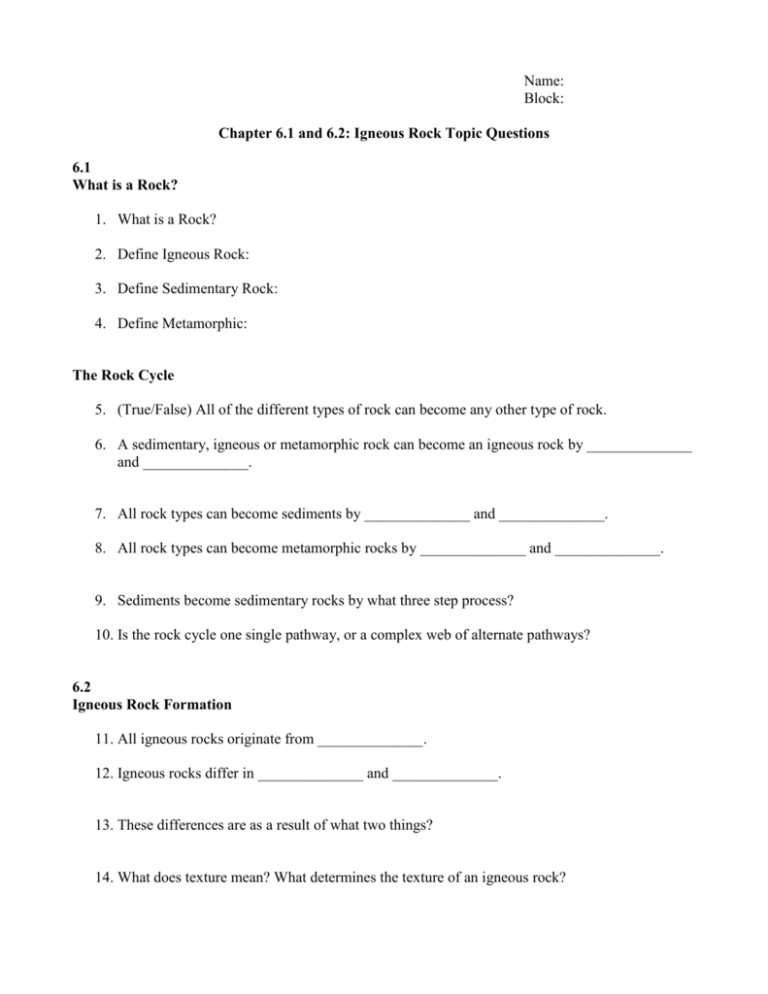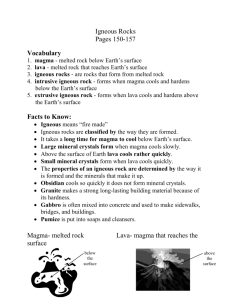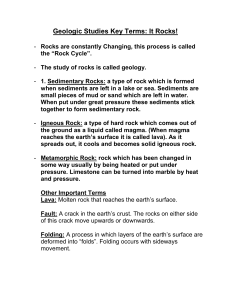Chapter 6.1 and 6.2: Igneous Rock Topic Questions
advertisement

Name: Block: Chapter 6.1 and 6.2: Igneous Rock Topic Questions 6.1 What is a Rock? 1. What is a Rock? 2. Define Igneous Rock: 3. Define Sedimentary Rock: 4. Define Metamorphic: The Rock Cycle 5. (True/False) All of the different types of rock can become any other type of rock. 6. A sedimentary, igneous or metamorphic rock can become an igneous rock by ______________ and ______________. 7. All rock types can become sediments by ______________ and ______________. 8. All rock types can become metamorphic rocks by ______________ and ______________. 9. Sediments become sedimentary rocks by what three step process? 10. Is the rock cycle one single pathway, or a complex web of alternate pathways? 6.2 Igneous Rock Formation 11. All igneous rocks originate from ______________. 12. Igneous rocks differ in ______________ and ______________. 13. These differences are as a result of what two things? 14. What does texture mean? What determines the texture of an igneous rock? 15. Igneous rock formed from lava above ground is called ______________ igneous rock, while igneous rock formed from magma below ground is called ______________ igneous rock. 16. Magma is classified as ______________ magma if it contains large amounts of silica, is thick and slow-flowing. 17. Felsic magma crystallizes into ______________-colored rock. 18. Mafic Magma contains large amounts of ______________ and ______________, and lower amounts of ______________. 19. Mafic magma crystallizes into _____________-colored rocks. 20. How fast does magma cool underground? 21. How does this affect the size of the mineral crystals that form? 22. What terms are used to describe the texture of intrusive rocks? 23. Magma that reaches the Earth’s surface is called ______________. 24. Cooled lava is described as ______________ or ______________ igneous rock. 25. Because lava cools relatively quickly, mineral crystals in volcanic rock are what size? 26. How is the texture of rocks with tiny crystals described? 27. Rocks that come from lava that cool so quickly that no crystals have time to form have a texture that is described as ______________. 28. Rocks that have both large and small crystals because part of the rock crystallized slowly while it was magma underground, and part of it cooled quickly as lava above ground is called a ______________. If this rock has large crystals surrounded by a fine-grained mass, what type of cookie would this look like? 29. Rock formed from lithified ash is called ______________. Igneous Rock Descriptions 30. Igneous rocks are grouped together based on what characteristic? 31. Specific igneous rocks are recognized by their ______________ and ______________. 32. Granitic rocks form from ______________ magmas. 33. Why is Granite coarse-grained? 33. What is the mineral composition of Granitic rocks? 34. If Granite forms from magma, how can it be found above ground? 35. Obsidian, also called volcanic glass, is a Felsic or Granitic rock. Why, then, is it black? 36. Why does Pumice have many holes in it? 37. Felsic lava would form which rock? Why? 38. What are the characteristics of rocks of the Gabbro family? 39. What are the most common minerals present in mafic rocks? 40. Gabbro, which has large crystals was formed above or below ground? What about Basalt? 41. What rock is the mafic equivalent of Pumice? 42. An intrusive or plutonic rock of intermediate composition would be? What about a volcanic rock of intermediate composition? Igneous Intrusions 43. Another name for any igneous intrusion (below ground) is called a ______________. 44. A horizontal igneous intrusion between bedding planes would be called a ______________. 45. A vertical igneous intrusion would form a ______________. 46. Laccoliths form what type of mountains that were discussed in chapter 11?








